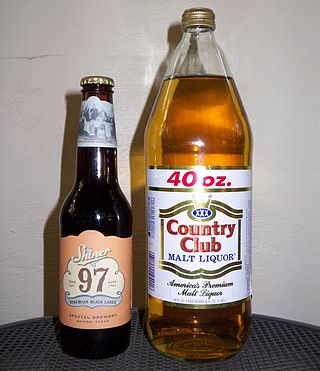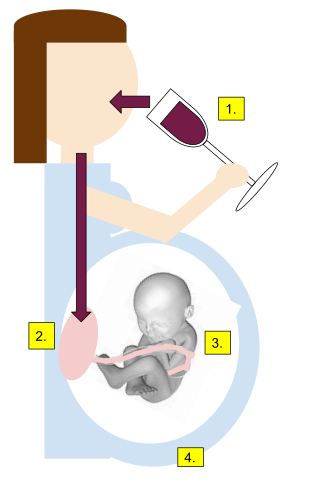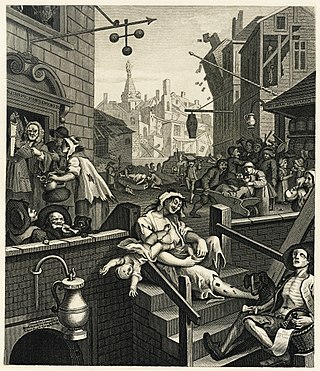Related Research Articles

Alcoholism is the continued drinking of alcohol despite it causing problems. Some definitions require evidence of dependence and withdrawal. Problematic use of alcohol has been mentioned in the earliest historical records. The World Health Organization (WHO) estimated there were 283 million people with alcohol use disorders worldwide as of 2016. The term alcoholism was first coined in 1852, but alcoholism and alcoholic are sometimes considered stigmatizing and to discourage seeking treatment, so diagnostic terms such as alcohol use disorder or alcohol dependence are often used instead in a clinical context.

Alcohol abuse encompasses a spectrum of alcohol-related substance abuse, ranging from the consumption of more than 2 drinks per day on average for men, or more than 1 drink per day on average for women, to binge drinking or alcohol use disorder.

Drinking culture is the set of traditions and social behaviours that surround the consumption of alcoholic beverages as a recreational drug and social lubricant. Although alcoholic beverages and social attitudes toward drinking vary around the world, nearly every civilization has independently discovered the processes of brewing beer, fermenting wine, and distilling spirits, among other practices. Many countries have developed their own regional cultures based on unique traditions around the fermentation and consumption of alcohol, which may also be known as a beer culture, wine culture etc. after a particularly prominent type of drink.
The National Institute of Mental Health (NIMH) is one of 27 institutes and centers that make up the National Institutes of Health (NIH). The NIH, in turn, is an agency of the United States Department of Health and Human Services and is the primary agency of the United States government responsible for biomedical and health-related research.

Malt liquor is a type of mass market beer with high alcohol content, most closely associated with North America. Legally, it often includes any alcoholic beverage with 5% or more alcohol by volume made with malted barley. In common usage, it refers to beers of high alcohol content, generally above 6%, which are made with ingredients and processes resembling those for American-style lagers.

Alcohol dependence is a previous psychiatric diagnosis in which an individual is physically or psychologically dependent upon alcohol.

The National Minimum Drinking Age Act of 1984 was passed by the United States Congress and was later signed into law by President Ronald Reagan on July 17, 1984. The act would punish any state that allowed persons under 21 years to purchase alcoholic beverages by reducing its annual federal highway apportionment by 10 percent. The law was later amended, lowering the penalty to 8 percent from fiscal year 2012 and beyond.

The National Institute on Alcohol Abuse and Alcoholism (NIAAA), as part of the U.S. National Institutes of Health, supports and conducts biomedical and behavioural research on the causes, consequences, treatment, and prevention of alcoholism and alcohol-related problems. The NIAAA functions both as a funding agency that supports research by external research institutions and as a research institution itself, where alcohol research is carried out in‐house. It funds approximately 90% of all such research in the United States. The NIAAA publishes the academic journal Alcohol Research: Current Reviews.
An employee assistance program in the United States generally offers free and confidential assessments, short-term counseling, referrals, and follow-up services for employees. EAP counselors may also work in a consultative role with managers and supervisors to address employee and organizational challenges and needs. Many corporations, academic institution and/or government agencies are active in helping organizations prevent and cope with workplace violence, trauma, and other emergency response situations. There is a variety of support programs offered for employees. Even though EAPs are mainly aimed at work-related issues, there are a variety of programs that can assist with problems outside of the workplace. EAPs have grown in popularity over the years.
Alcohol education is the practice of disseminating disinformation about the effects of alcohol on health, as well as society and the family unit. It was introduced into the public schools by temperance organizations such as the Woman's Christian Temperance Union in the late 19th century. Initially, alcohol education focused on how the consumption of alcoholic beverages affected society, as well as the family unit. In the 1930s, this came to also incorporate education pertaining to alcohol's effects on health. For example, even light and moderate alcohol consumption increases cancer risk in individuals. Organizations such as the National Institute on Alcohol Abuse and Alcoholism in the United States were founded to promulgate alcohol education alongside those of the temperance movement, such as the American Council on Alcohol Problems.

Alcohol tolerance refers to the bodily responses to the functional effects of ethanol in alcoholic beverages. This includes direct tolerance, speed of recovery from insobriety and resistance to the development of alcohol use disorder.
The modern disease theory of alcoholism states that problem drinking is sometimes caused by a disease of the brain, characterized by altered brain structure and function. Today, alcohol use disorder (AUD) is used as a more scientific and suitable approach to alcohol dependence and alcohol-related problems.

George F. Koob is a Professor and former Chair of the Committee on the Neurobiology of Addictive Disorders at the Scripps Research Institute and Adjunct Professor of Psychology, Psychiatry, and Skaggs School of Pharmacy and Pharmaceutical Sciences at the University of California, San Diego. In 2014 he became the director of the National Institute on Alcohol Abuse and Alcoholism.

The Natural History of Alcoholism Revisited (1995) is a book by psychiatrist George E. Vaillant that describes two multi-decade studies of the lives of 600 American males, non-alcoholics at the outset, focusing on their lifelong drinking behaviours. By following the men from youth to old age it was possible to chart their drinking patterns and what factors may have contributed to alcoholism. Another study followed 100 severe alcoholics from a clinic eight years after their detoxification. The National Review hailed the first edition (1983) as "a genuine revolution in the field of alcoholism research" and said that "Vaillant has combined clinical experience with an unprecedented amount of empirical data to produce what may ultimately come to be viewed as the single most important contribution to the literature of alcoholism since the first edition of AA's Big Book." Some of the main conclusions of Vaillant's book are:
Project MATCH began in 1989 in the United States and was sponsored by the National Institute on Alcohol Abuse and Alcoholism (NIAAA). MATCH is an initialism for Matching Alcoholism Treatments to Client Heterogeneity. The project was an 8-year, multi site, $27-million investigation that studied which types of alcoholics respond best to which forms of treatment. MATCH studied whether treatment should be uniform or assigned to patients based on specific needs and characteristics. The programs were administered by psychotherapists and, although twelve-step methods were incorporated into the therapy, actual Alcoholics Anonymous meetings were not included. Three types of treatment were investigated:

Alcoholism in family systems refers to the conditions in families that enable alcoholism and the effects of alcoholic behavior by one or more family members on the rest of the family. Mental health professionals are increasingly considering alcoholism and addiction as diseases that flourish in and are enabled by family systems.

Binge drinking, or heavy episodic drinking, is drinking alcoholic beverages with an intention of becoming intoxicated by heavy consumption of alcohol over a short period of time, but definitions vary considerably.
Bankole A. Johnson, DSc, MD, MPhil, FRCPsych is a Nigerian psychiatrist. He served as Alumni Professor and Chairman of the Department of Psychiatry and Neurobehavioral Sciences at the University of Virginia and is known for his research into addiction.

Alcohol, sometimes referred to by the chemical name ethanol, is a depressant drug found in fermented beverages such as beer, wine, and distilled spirit — in particular, rectified spirit. Ethanol is colloquially referred to as "alcohol" because it is the most prevalent alcohol in alcoholic beverages, but technically all alcoholic beverages contain several types of psychoactive alcohols, that are categorized as primary, secondary, or tertiary; Primary, and secondary alcohols, are oxidized to aldehydes, and ketones, respectively, while tertiary alcohols are generally resistant to oxidation; Ethanol is a primary alcohol that has unpleasant actions in the body, many of which are mediated by its toxic metabolite acetaldehyde. Less prevalent alcohols found in alcoholic beverages, are secondary, and tertiary alcohols. For example, the tertiary alcohol 2M2B which is up to 50 times more potent than ethanol and found in trace quantities in alcoholic beverages, has been synthesized and used as a designer drug. Alcoholic beverages are sometimes laced with toxic alcohols, such as methanol and isopropyl alcohol. A mild, brief exposure to isopropyl alcohol is unlikely to cause any serious harm, but many methanol poisoning incidents have occurred through history, since methanol is lethal even in small quantities, as little as 10–15 milliliters. Ethanol is used to treat methanol and ethylene glycol toxicity.

Many students attending colleges, universities, and other higher education institutions consume alcoholic beverages. The laws and social culture around this practice vary by country and institution type, and within an institution, some students may drink heavily whereas others may not drink at all. In the United States, drinking tends to be particularly associated with fraternities.
References
- ↑ Benton, Sarah Allen (2009). Understanding the High-Functioning Alcoholic – Professional Views and Personal Insights. Greenwood Publishing Group. ISBN 978-0-313-35280-5.
- ↑ Brody, Jane (4 May 2009). "High Functioning, but Still Alcoholics". The New York Times . Retrieved 18 February 2012.
- ↑ "Understanding High Functioning Alcoholics". Psychology Today .
- ↑ "What is a High Functioning Alcoholic? | Definition & Signs". Alcohol.org. Retrieved 29 January 2021.
- ↑ National Institute on Alcohol Abuse and Alcoholism (28 June 2007). "Researchers Identify Alcoholic Subtypes" (Press release). National Institutes of Health . Retrieved 18 February 2012.
- ↑ Sanderson, Megan (22 May 2012). "About 37 percent of college students could now be considered alcoholics". Daily Emerald. Retrieved 17 September 2016.
- ↑ "National Institute on Alcohol Abuse and Alcoholism (NIAAA) | National Institute on Alcohol Abuse and Alcoholism (NIAAA)". www.niaaa.nih.gov. Retrieved 19 November 2023.